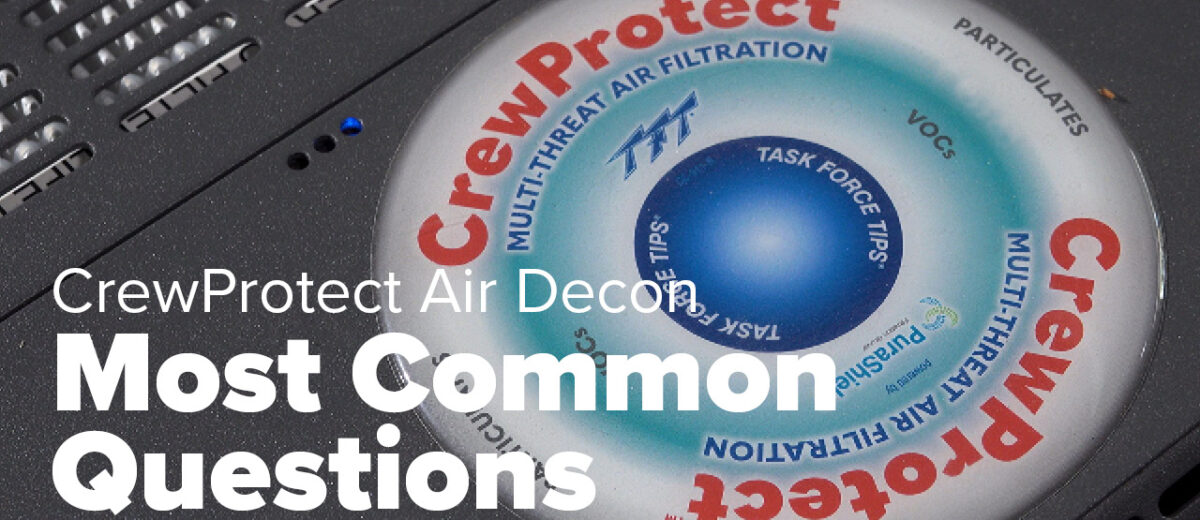Your 9 Most Common Questions About CrewProtect Air Decontamination Systems
You care about protecting your crew, from the time they enter the station until they leave to go home to their families. You also know that air contamination is a major threat to firefighters, contributing to a host of diseases, cancers, and health concerns. The good news is that you can protect your crew from these often-invisible threats with a comprehensive air decontamination and filtration system.
CrewProtect tackles major air quality threats in your cab including volatile organic compounds (VOCs) and particulates. We created this solution for firefighters like you who need a simple solution with minimal maintenance.
In this article we will address some of the most common questions we receive about the CrewProtect Air Decontamination system and help you understand how it can protect your crew with minimal upkeep on your end.
CrewProtect FAQ
What is the maximum cubic feet (CF) CrewProtect can effectively decontaminate and filter?
CrewProtect 100 operates at 100 cubic feet per minute (CFM). This means you can clean your 350 cubic foot cabin in approximately 3.5 minutes. Your 500 cubic foot cabin would take five minutes with one unit, or just 2.5 minutes with a second unit running at the same time.
The CrewProtect 50 is a smaller unit intended for wildland vehicles or ambulances. These units operate at 50 CFM.
The CrewProtect 20 is a smaller unit intended for tiller cabs or Chief’s vehicles. These units operate at 20 CFM.
When installing the unit, is there a minimum clearance needed?
For the best results, your CrewProtect needs to be installed with at least two inches of clearance from the front inlet grill to allow for proper airflow.
You can mount the unit in virtually any orientation you need for your apparatus and can even have one of the side inlet grills completely covered. Covering one of the side inlet grills will not reduce effectiveness.
Can the CrewProtect be installed on in-service vehicles?
Absolutely! There are only two wires and six screws or bolts needed for installation. This makes the unit easy for your mechanic to install virtually anywhere in the apparatus cab or in an ambulance. We recommend the ceiling, wall, or doghouse for most apparatus.
How often do I need to change the CrewProtect cartridge?
Your cartridge will need to be changed every six months or after 1,800 hours of cumulative use. The unique four-stage cartridge is designed to provide you with 100% effectiveness from day one through cartridge replacement on day 183. Since the unit turns on and off with your apparatus and cartridges only need to be replaced every six months, CrewProtect is easy for you and your crew to manage.
Wondering what a cartridge change looks like?
How do I know when the cartridge needs to be replaced?
Your CrewProtect has a panel of easy-to-understand indicator lights that explain the status of the cartridge. Each cartridge has a unique RFID chip that allows the unit to communicate with the cartridge and know where it is in its lifecycle.
When you see a blue light, it means the cartridge is still good. When the light changes to amber, around the five-month mark, you know it is nearly time to replace the cartridge. This gives you time to order a cartridge or get one you’ve already ordered ready to go. Once the light turns red the cartridge must be replaced for the unit to continue functioning.
What happens if the cartridge is not changed when the red indicator light turns on?
Once the red indicator light comes on, your CrewProtect will stop running until a new cartridge is installed. This means your crew will not be protected from airborne threats until the cartridge is replaced.
Because CrewProtect is designed to give you 100% protection from day 1 to day 183, you cannot trick the system. Cartridges each have a unique RFID chip that tells the CrewProtect unit where it is in its lifecycle. Simply removing the cartridge and placing the same one, or another expired one, back in will not make the unit function. Only a cartridge that has not exceeded its lifespan will work properly.
What do I do with the used cartridge?
CrewProtect is designed to be as simple as possible for you to use and maintain. Once your cartridge has expired, you can simply throw it in the trash bin like any other garbage. The design of the CrewProtect cartridge neutralizes and encapsulates harmful contaminants, making it easy to deal with at the end of its life.
Can the CrewProtect get wet with water, snow, coffee, cleaning sprays, etc.?
Yes! We know the cab situation may get messy at times, which is why the unit is designed to withstand the rigor of cab traffic. Each unit is made from steel and powder coated inside and out to ensure it is durable. Basic use, spills, and cleaning will not damage your CrewProtect.
If you get a lot of liquid on your unit and the cartridge becomes very wet, you should remove the cartridge and allow it to dry completely before reinstalling. This will ensure it can work at maximum effectiveness.
What happens if the decontamination unit is inadvertently covered with something, such as a bunker jacket?
If you or a member of your crew inadvertently cover the inlet or outlet vents on the unit, it will shut off due to lack of airflow. Once the obstruction is removed, CrewProtect will return to normal function. Remember, if your CrewProtect unit is covered and shuts down, it is not protecting your crew. It can only clean the air when it is operational.
How do I see CrewProtect in action?
Now that you know some of the most common questions and answers about CrewProtect, you may be wondering what CrewProtect looks like in action. You can see CrewProtect in action with this short video.

